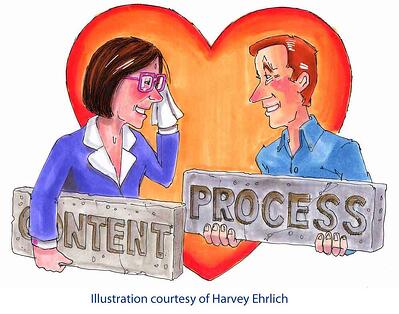By Jay Terwilliger
President, Creative Realities, Inc.

In recent articles in both the New York Times (January 13 by Susan Cain) and The New Yorker (January 30, by Jonah Lehrer), the concept of brainstorming as introduced in the 1940’s by Alex Osborn has been attacked as ineffective and linked to the concept of “GroupThink”.
Susan Cain describes the New Groupthink as holding “that creativity and achievement come from an oddly gregarious place.” She decries that now “most of us work in teams, in offices without walls, for managers who prize people skills above all. Lone geniuses are out. Collaboration is in.” Her major point is that this view conflicts with research that suggests that “people are more creative when they enjoy privacy and freedom from interruption.” And that the most spectacularly creative people in many fields are often introverts who are more comfortable working alone.
I have no issue with the premise of the importance of the passionate individual to create focused and powerful ideas. My issue is with the way both have attacked Alex Osborn’s concept of brainstorming as a powerful collaborative thinking tool. My reasons are outlined in a previous blog “Let’s not confuse good brainstorming with the new “Groupthink.” Suffice it to say for the purposes of this blog, that I dislike “GroupThink” as much as the next person. But I am a strong advocate of the power of collaboration in innovation, and that the proper use of brainstorming techniques are a key tool in the collaborative approach. For more on the fundamental rules of brainstorming, Alex’s book “Your Creative Power” or my prior blog.
Today I want to share “3 Keys to Avoiding Groupthink” when using any brainstorming technique or convening any group or team for collaborative thinking. They are simple, and eliminate the negative aspects of “Groupthink”. Before I do, since neither Susan nor Jonah ever really defined what they mean by “Groupthink” in their articles, let’s use the Wikipedia definition of “Groupthink” as a starting point.

“Groupthink is a psychological phenomenon that occurs within groups of people. It is the mode of thinking that happens when the desire for harmony in a decision-making group overrides a realistic appraisal of alternatives.”
Used improperly, Osborn’s process of brainstorming can promote this what we call the “Kumbaya” effect – that’s consensus – NOT collaboration. So, how do you engage a team in collaborative thinking and avoid this outcome? First, let’s assume you have read the book or been trained, etc. and understand the rules of brainstorming. Here’s what separates “Groupthink” from “Collaboration.”

1. Assemble a Diverse Team
We have a saying “If you want to solve a marketing problem, don’t put a team of marketers in the room.” The same is true for sales, HR, operations, etc. If you do not field a multi-disciplinary team of diverse thinkers, you have little chance of avoiding “GroupThink.” Why? They see with the same eyes, they hear with the same ears, they react with the same rules and they apply the same tools and metrics. They think alike!
So the first rule is to assemble a diverse team. Build your team with people from different disciplines, different cultures, different age groups (you would be amazed at the power of a Millenial in a pack of X’ers and Boomers). And be sure there are some members who have necessary and relevant expertise, and some that are naïve (we call them “WildCards”) about the issue. We once ran a session for a client team composed of a range of scientists and technologists from Bell Labs where 25 new patent applications were filed – 20 of which came from the participation of a 70 year-old grandmother!
And when you are considering candidates, include different styles of participation and thinking. We identify three types for our brainstorming – Explorers (extroverted, inquisitive, comfortable with ambiguity, free-thinking), Developers (creative problem-solvers, sometimes introverted, quieter, but love being given a problem or challenge to solve), and Commercializers (realists, business-minded, etc.).
Proper use of brainstorming techniques will encourage all of these diverse types to play, bring them out of their shells where possible, tone down the influence of the extroverts, and leverage each others thinking to not only identify a range of possibilities, but also in smaller sub-groups or as individuals, find ways to make the newer ideas feasible.

2. Focus Roles – Client, Facilitator, Resources
Somebody has to own the effort. That individual may have a lieutenant, but clientship cannot rest with the full team or even a large subset. That is a sure way to generate “Groupthink.” Instead, one person must make the decisions. The team should advise them, and advocate for their positions with passion, but ultimately, for the client has to exercise leadership and decision-making. They must pick the notions they believe to have potential for further development. And ultimately, they must pick the final concepts to recommend or implement. This role cannot be delegated.
And they should not be in charge of running the meeting/dialogue. They must keep their heads in the “content” and not worry about, or unduly influence the process. Someone else should be in charge of the process – facilitating the interaction, drawing out the range of perspectives, doing the Alex Osborn thing non-judgmentally.
Everyone else is in the resource role. Focus on listening, learning, ideating, building on other offers that intrigue you, etc. Resources advocate, but do not decide! If everyone in the room has to agree, then the outcome will be the worst possible aspect of Groupthink – a decision in favor of the lowest common denominator – devoid of originality, risk or newness – what everyone can envision and agree to. BLAH.

3. Encourage Individual Champions
Lot’s of people understand Keys 1 & 2. But if they miss this one, they miss the real power of collaborative thinking – the power of one. Seems like an oxymoron doesn’t it? It’s not. Collaboration helps broaden understanding and perspectives. It unleashes ideas an individual may not have thought of by themselves, increasing the “possibilities.”
And the client, as indicated above, has not only the right, but the obligation to pick the ideas, concepts, etc. that they want to see developed and moved forward. But often, it’s the idea that no one else quite sees, that the group does not understand well enough to advocate for that has the most newness and potential to change the game. It’s clear in the individual’s mind, but has not yet been illustrated or thought through enough to intrigue the group. That is the role of the Individual Champion.
In our work, after our “divergent” thinking period, after the group and client have played their roles in “convergence”, and after we have dutifully engaged teams in developing the ideas selected by the “client”, we open the session up to “Individual Champions.” Anyone, alone, or if they need/want help from someone else, can pick any idea and develop it into a complete concept in their own way. Even if it is an idea that has already been developed by the team in one direction, an Individual Champion may see it very differently, and develop it in a totally different manner. Or they can pick any idea that was not advocated by the group or selected by the client, and develop it as they see fit.
This is not an idle exercise. Just as we protect each individual during the collaborative “brainstorming”, we protect every idea as well. The client is not allowed to veto any Individual Champion offer. It must go through the same vetting process as the ideas they selected.
Now that it is developed and clarified, it’s amazing what can happen. Ideas no one else could imagine now have the opportunity to capture their interest. In our work, we find that Individual Champion ideas, often account for 20-30% of the total numbers of ideas that make it into final concepts, often 50% of those that make it through internal and external vetting. What’s more, they are often the most “breakthrough” in terms of truly new, game-changing concepts.
Collaborative innovation involves the “Genius of the ‘and” versus the tyranny of the ‘or’.” It’s not that collaborative thinking must always turn into “Groupthink” or that introverts or individuals have the best ideas. In good brainstorming, one feeds off the other and the end result is significantly more powerful than either approach alone.
So don’t let worries about “Groupthink” dissuade you from engaging in collaborative innovation. Learn the rules, learn the keys and use it to help you grow your business. In the end, innovation is about overcoming obstacles and implementing ideas, not just generating them. And you have a much greater chance of successful implementation if you have people involved who helped create the idea. Collaboration is not only a powerful idea generating approach, it is critical to successful implementation. Avoid the “Not Invented Here” situation where teams provide only lukewarm support for implementation. People have a passion for implementing things they help to create!
 Call Us: 508.359.6048
Call Us: 508.359.6048




